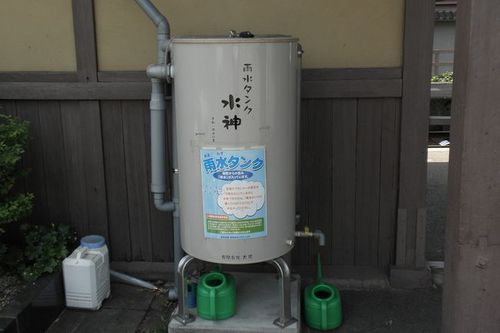August 24, 2014
Let's Use Rainwater! Recent Trends in Rainwater Use in Japan
Keywords: Water

Image by oseigt Some Rights Reserved.
In recent years, a growing number of municipalities in Japan have been making use of rainwater. Blessed with a large amount of rainfall compared to other countries, since the post-war urban development period Japan has tended to deal with this abundance by "disposing" of rainwater. Over the years, however, this thinking has gradually shifted toward taking advantage of rainwater as a natural resource. In this article, we will introduce the recent trends in rainwater use in Japan.
The earthquake and tsunami that struck northern Japan in March 2011 caused sudden rise in the number of households that are installing tanks to store rainwater for emergencies. The size and style of these tanks vary widely, from a small storage capacity of 100 liters to a large storage capacity of 1,000 liters, including tanks used as garden furniture made of terra cotta. Installation costs range from several thousand yen to several tens of thousands of yen.
The number of municipalities offering subsidies for the installation of rainwater tanks is also increasing. According to a survey conducted by the Association for Rainwater Storage and Infiltration Technology in April 2011, 208 municipalities in Japan are implementing subsidy programs for the installation of facilities for storing or filtering rainwater. Of these, 179 are providing subsidies for rainwater storage (in other words, rainwater tanks). Sumida Ward was the first ward in Tokyo to promote the utilization of rainwater. For residents wanting to install a rainwater tank with a capacity of less than 1,000 liters, the city will subsidize half of the cost of the tank (up to 40,000 yen), including installation costs.
Amidst these trends, in April 2014 the Japanese Diet passed the Act to Advance the Utilization of Rainwater, which went into force the following May. Under the Act, municipalities are required to make their best effort to set and work toward rainwater utilization targets, and the national government will provide financial support for subsidy programs. With these new responsibilities stipulated for the national government, local authorities, and enterprises, we can expect to see a nationwide move to promote rainwater use.

Image by detch* Some Rights Reserved.
There are many uses for rainwater. It can reduce tap water consumption if used for domestic purposes such as toilet flushing, car washing, gardening, and cleaning and cooling down paths and pavement. When the water supply is cut off by disaster, water pipe rupture, or other emergency, stored rainwater also becomes a vital water source that can be used for fire fighting and domestic purposes, and even as drinking water if properly filtered and boiled.
Utilizing rainwater also helps alleviate what is known as urban flooding. In concrete-blanketed urban areas, rainwater flows straight to sewer pipes instead of percolating through the soil. In a torrential downpour, rainwater quickly inundates the sewer system, exceeding the capacity of its pipes and causing wastewater to backflow onto the ground through manholes and other openings. One way to prevent this urban flooding is to store rainwater at each building, which in turn reduces the excess water discharged to the sewer.
You can build your own rainwater tank any number of ways and with readily available products such as plastic buckets. The Japanese organization People for Rainwater, for instance, provides such how-to information on its website. You can also learn more about rainwater utilization at the Rainwater Museum run by Sumida Ward, Tokyo, the only facility of its kind in Japan. The museum shows rainwater utilization techniques and water issues not only from the local area but also from around the world, and displays different types of rainwater storage tanks.
Related
"JFS Newsletter"
- Fifth Contest to Award Excellent Environmental and Social Practices by Junior High, High School Students
- TMG Sewerage Bureau Aims to Make Tokyo a 'Smart Energy City'
- Learning from the Past: Traditional Flood Control Systems in Japan's Kofu Basin
- Yahaba Waterworks Supporters Workshop -- Citizens Decide on the Future of the Water Supply
- Arase Dam: Japan's First Dam Removal Project Underway
Related
"Popular Articles"
- Cabinet of Japan Decide to Make Full Use of Rainwater in Newly Constructed Buildings
- Japan Facing Water Shortages in Some Areas: 2010 Water Resources Report
- A Cup of Water Saving Children's Lives
- MOE Publishes Cases of Water Footprint Calculations to Visualize Water Use
- Japanese Technology to Help Address Global Water Problems


